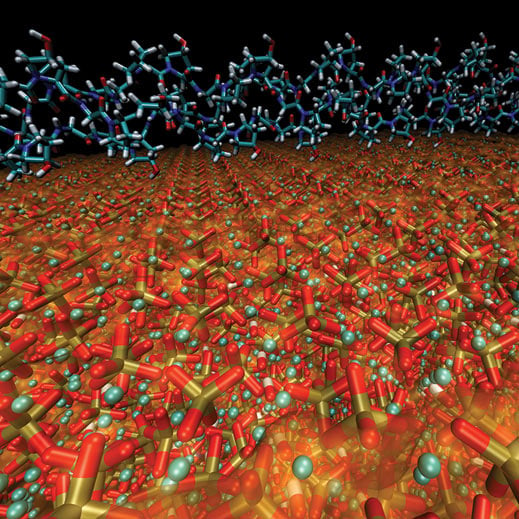The Heart of Bone
A team of MIT researchers led by civil engineer and materials scientist Markus Buehler has finally unraveled the structure of bone—a long-standing mystery—with almost atom-by-atom precision. Doing so took many years of analysis by some of the world’s most powerful computers, results that were confirmed by laboratory experiments.

Buehler says the biggest question was how two different materials—a soft, flexible biomolecule called collagen and a hard, brittle form of the mineral apatite—combine to form something that is simultaneously hard, tough, and slightly flexible.
The constituents are so different that “you can’t take these two materials individually and understand how bone behaves,” Buehler says. Hydroxyapatite is like chalk, he says: “It’s very brittle. If you try to bend it even a little, it breaks into pieces.” Collagen, on the other hand, is what gelatin is made of—the very epitome of a wobbly substance.
The team found that “tiny hydroxyapatite grains [are] embedded in the collagen matrix,” allowing the two materials to “each contribute the best of their properties,” Buehler says. “Hydroxyapatite takes most of the forces in the material, whereas collagen takes most of the stretching.”
The new understanding of bone’s molecular structure and function could help in determining what goes wrong in diseases such as osteoporosis and brittle bone disease.
Keep Reading
Most Popular
Large language models can do jaw-dropping things. But nobody knows exactly why.
And that's a problem. Figuring it out is one of the biggest scientific puzzles of our time and a crucial step towards controlling more powerful future models.
How scientists traced a mysterious covid case back to six toilets
When wastewater surveillance turns into a hunt for a single infected individual, the ethics get tricky.
The problem with plug-in hybrids? Their drivers.
Plug-in hybrids are often sold as a transition to EVs, but new data from Europe shows we’re still underestimating the emissions they produce.
Google DeepMind’s new generative model makes Super Mario–like games from scratch
Genie learns how to control games by watching hours and hours of video. It could help train next-gen robots too.
Stay connected
Get the latest updates from
MIT Technology Review
Discover special offers, top stories, upcoming events, and more.